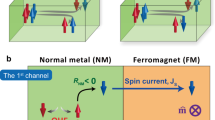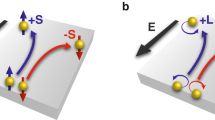Abstract
Electrons carry both spin and orbital angular momentum. The search for phenomena that generate a flow of spin angular momentum—a spin current—has led to the development of spintronics. In contrast, the orbital counterpart of spin current—an orbital current—has largely been overlooked, and the generation of an orbital current remains challenging. Here we report the observation of orbital-current generation from magnetization dynamics: orbital pumping. We show that orbital pumping in nickel/titanium bilayers injects an orbital current into the titanium layer, which we detect through the inverse orbital Hall effect. Orbital pumping is the orbital counterpart of spin pumping, a versatile and powerful mechanism for spin-current generation. Our findings could, thus, provide a promising approach for generating orbital currents and could help in the development of the orbital analogue of spintronics: orbitronics.
This is a preview of subscription content, access via your institution
Access options
Access Nature and 54 other Nature Portfolio journals
Get Nature+, our best-value online-access subscription
$32.99 / 30 days
cancel any time
Subscribe to this journal
Receive 12 digital issues and online access to articles
$119.00 per year
only $9.92 per issue
Buy this article
- Purchase on SpringerLink
- Instant access to full article PDF
Prices may be subject to local taxes which are calculated during checkout





Similar content being viewed by others
Data availability
The data that support the findings of this study are available from the corresponding author upon reasonable request.
References
Maekawa, S., Valenzuela, S. O., Saitoh, E. & Kimura, T. (eds.) Spin Current (Oxford Univ. Press, 2012).
Manchon, A. et al. Current-induced spin-orbit torques in ferromagnetic and antiferromagnetic systems. Rev. Mod. Phys. 91, 035004 (2019).
Ryu, J., Lee, S., Lee, K.-J. & Park, B.-G. Current-induced spin-orbit torques for spintronic applications. Adv. Mater. 32, 1907148 (2020).
Hirohata, A. et al. Review on spintronics: principles and device applications. J. Magn. Magn. Mater. 509, 166711 (2020).
Dieny, B. et al. Opportunities and challenges for spintronics in the microelectronics industry. Nat. Electron. 3, 446–459 (2020).
Mizukami, S., Ando, Y. & Miyazaki, T. Effect of spin diffusion on Gilbert damping for a very thin permalloy layer in Cu/permalloy/Cu/Pt films. Phys. Rev. B 66, 104413 (2002).
Tserkovnyak, Y., Brataas, A. & Bauer, G. E. W. Enhanced Gilbert damping in thin ferromagnetic films. Phys. Rev. Lett. 88, 117601 (2002).
Tserkovnyak, Y., Brataas, A., Bauer, G. E. W. & Halperin, B. I. Nonlocal magnetization dynamics in ferromagnetic heterostructures. Rev. Mod. Phys. 77, 1375 (2005).
Kajiwara, Y. et al. Transmission of electrical signals by spin-wave interconversion in a magnetic insulator. Nature 464, 262–266 (2010).
Wang, H., Du, C., Hammel, P. C. & Yang, F. Antiferromagnonic spin transport from Y3Fe5O12 into NiO. Phys. Rev. Lett. 113, 097202 (2014).
Noël, P. et al. Non-volatile electric control of spin-charge conversion in a SrTiO3 Rashba system. Nature 580, 483–486 (2020).
Go, D., Jo, D., Lee, H.-W., Kläui, M. & Mokrousov, Y. Orbitronics: orbital currents in solids. Europhys. Lett. 135, 37001 (2021).
Kim, J. & Otani, Y. Orbital angular momentum for spintronics. J. Magn. Magn. Mater. 563, 169974 (2022).
Go, D. & Lee, H.-W. Orbital torque: torque generation by orbital current injection. Phys. Rev. Res. 2, 013177 (2020).
Chen, X. et al. Giant antidamping orbital torque originating from the orbital Rashba–Edelstein effect in ferromagnetic heterostructures. Nat. Commun. 9, 2569 (2018).
Kim, J. et al. Nontrivial torque generation by orbital angular momentum injection in ferromagnetic-metal/Cu/Al2O3 trilayers. Phys. Rev. B 103, L020407 (2021).
Tazaki, Y. et al. Current-induced torque originating from orbital current. Preprint at https://arxiv.org/abs/2004.09165 (2020).
Ding, S. et al. Harnessing orbital-to-spin conversion of interfacial orbital currents for efficient spin-orbit torques. Phys. Rev. Lett. 125, 177201 (2020).
Lee, S. et al. Efficient conversion of orbital Hall current to spin current for spin-orbit torque switching. Commun. Phys. 4, 234 (2021).
Lee, D. et al. Orbital torque in magnetic bilayers. Nat. Commun. 12, 6710 (2021).
Choi, Y.-G. et al. Observation of the orbital Hall effect in a light metal Ti. Nature 619, 52–56 (2023).
Hayashi, H. et al. Observation of long-range orbital transport and giant orbital torque. Commun. Phys. 6, 32 (2023).
Sala, G. & Gambardella, P. Giant orbital Hall effect and orbital-to-spin conversion in 3d, 5d, and 4f metallic heterostructures. Phys. Rev. Res. 4, 033037 (2022).
Go, D. et al. Orbital pumping by magnetization dynamics in ferromagnets. Preprint at https://arxiv.org/abs/2309.14817 (2023).
Go, D. et al. Theory of current-induced angular momentum transfer dynamics in spin-orbit coupled systems. Phys. Rev. Res. 2, 033401 (2020).
Du, C., Wang, H., Yang, F. & Hammel, P. C. Systematic variation of spin-orbit coupling with d-orbital filling: large inverse spin Hall effect in 3d transition metals. Phys. Rev. B 90, 140407 (2014).
Saitoh, E., Ueda, M., Miyajima, H. & Tatara, G. Conversion of spin current into charge current at room temperature: inverse spin-Hall effect. Appl. Phys. Lett. 88, 182509 (2006).
Ando, K. et al. Inverse spin-Hall effect induced by spin pumping in metallic system. J. Appl. Phys. 109, 103913 (2011).
Harder, M., Cao, Z. X., Gui, Y. S., Fan, X. L. & Hu, C.-M. Analysis of the line shape of electrically detected ferromagnetic resonance. Phys. Rev. B 84, 054423 (2011).
Iguchi, R. & Saitoh, E. Measurement of spin pumping voltage separated from extrinsic microwave effects. J. Phys. Soc. Jpn 86, 011003 (2017).
Flovik, V., Macià, F., Kent, A. D. & Wahlström, E. Eddy current interactions in a ferromagnet-normal metal bilayer structure, and its impact on ferromagnetic resonance lineshapes. J. Appl. Phys. 117, 143902 (2015).
Chuang, T. C., Su, P. L., Wu, P. H. & Huang, S. Y. Enhancement of the anomalous Nernst effect in ferromagnetic thin films. Phys. Rev. B 96, 174406 (2017).
Zhou, H. et al. Spatial symmetry of spin pumping and inverse spin Hall effect in the Pt/Y3Fe5O12 system. Phys. Rev. B 94, 134421 (2016).
Harder, M., Gui, Y. & Hu, C.-M. Electrical detection of magnetization dynamics via spin rectification effects. Phys. Rep. 661, 1–59 (2016).
Yoshino, T. et al. Universality of the spin pumping in metallic bilayer films. Appl. Phys. Lett. 98, 132503 (2011).
Salemi, L. & Oppeneer, P. M. First-principles theory of intrinsic spin and orbital Hall and Nernst effects in metallic monoatomic crystals. Phys. Rev. Mater. 6, 095001 (2022).
Amin, V. P., Haney, P. M. & Stiles, M. D. Interfacial spin-orbit torques. J. Appl. Phys. 128, 151101 (2020).
Seifert, T. S. et al. Time-domain observation of ballistic orbital-angular-momentum currents with giant relaxation length in tungsten. Nat. Nanotechnol. 18, 1132–1138 (2023).
Santos, E. et al. Inverse orbital torque via spin-orbital intertwined states. Phys. Rev. Appl. 19, 014069 (2023).
Ando, K. et al. Electrically tunable spin injector free from the impedance mismatch problem. Nat. Mater. 10, 655–659 (2011).
Watanabe, S. et al. Polaron spin current transport in organic semiconductors. Nat. Phys. 10, 308–313 (2014).
Jeon, K.-R. et al. Enhanced spin pumping into superconductors provides evidence for superconducting pure spin currents. Nat. Mater. 17, 499–503 (2018).
Shiomi, Y. et al. Spin-electricity conversion induced by spin injection into topological insulators. Phys. Rev. Lett. 113, 196601 (2014).
Iguchi, R. et al. Spin pumping without three-magnon splitting in polycrystalline Bi1Y2Fe5O12/Pt bilayer structure. Jpn J. Appl. Phys. 51, 103004 (2012).
Gupta, S. et al. Broadband strip-line ferromagnetic resonance spectroscopy of soft magnetic CoFeTaZr patterned thin films. AIP Adv. 8, 056125 (2018).
Acknowledgements
This work was supported by the Japan Society for the Promotion of Science (JSPS; KAKENHI Grant Nos. 22H04964, 20H00337 and 20H02593 to K.A.), the Spintronics Research Network of Japan (grant to K.A.) and the Ministry of Education, Culture, Sports, Science and Technology’s Initiative to Establish Next-generation Novel Integrated Circuit Centers (Grant No. JPJ011438 to K.A.). H.H. is supported by a JSPS grant-in-aid for research fellowship for young scientists (Grant No. 20J20663) and JSPS (KAKENHI Grant No. 23K19037). D.G. and Y.M. acknowledge the German Research Foundation (Grant Nos. TRR 173/2-268565370-Spin+X (Project A11) and TRR 288-422213477 (Project B06)) for funding. D.G. and Y.M. gratefully acknowledge the Jülich Supercomputing Centre for providing computational resources under project jiff40.
Author information
Authors and Affiliations
Contributions
H.H. and S.H. fabricated the devices, collected and analysed the data, and characterized the materials. H.H. and K.A. designed the experiments. H.H., D.G., Y.M. and K.A. developed the explanation. H.H. and K.A. wrote the paper with help from D.G and Y.M. All authors discussed the results and reviewed the paper. K.A. supervised the study.
Corresponding author
Ethics declarations
Competing interests
The authors declare no competing interests.
Peer review
Peer review information
Nature Electronics thanks Henri Jaffrès, Pranaba Muduli and the other, anonymous, reviewer(s) for their contribution to the peer review of this work.
Additional information
Publisher’s note Springer Nature remains neutral with regard to jurisdictional claims in published maps and institutional affiliations.
Supplementary information
Supplementary Information
Supplementary Notes 1–7 and Figs. 1–11.
Rights and permissions
Springer Nature or its licensor (e.g. a society or other partner) holds exclusive rights to this article under a publishing agreement with the author(s) or other rightsholder(s); author self-archiving of the accepted manuscript version of this article is solely governed by the terms of such publishing agreement and applicable law.
About this article
Cite this article
Hayashi, H., Go, D., Haku, S. et al. Observation of orbital pumping. Nat Electron 7, 646–652 (2024). https://doi.org/10.1038/s41928-024-01193-1
Received:
Accepted:
Published:
Issue date:
DOI: https://doi.org/10.1038/s41928-024-01193-1
This article is cited by
-
Orbitronics in two-dimensional materials
npj Spintronics (2025)
-
Acoustic generation of orbital currents
Nature Communications (2025)
-
Signatures of longitudinal spin pumping in a magnetic phase transition
Nature (2025)
-
Absence of orbital current torque in Ta/ferromagnet bilayers
Nature Communications (2025)
-
Orbital torque switching of room temperature two-dimensional van der Waals ferromagnet Fe3GaTe2
Nature Communications (2025)



